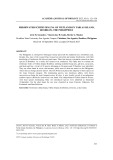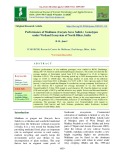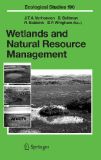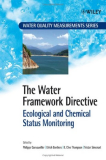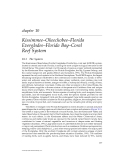
Freshwater wetlands
-
Ebook "Marine, freshwater, and wetlands biodiversity conservation" gathers together a wide range of papers reporting on key research into the biodiversity conservation of these critical and increasingly threatened habitats. Collectively these papers provide a snap-shot of the types of problems they are experiencing, and offer a wealth of topical examples which render this volume especially valuable to teachers of courses in marine, freshwater and wetlands ecology, biological conservation and ecological restoration.
 397p
397p  tachieuhoa
tachieuhoa
 28-01-2024
28-01-2024
 3
3
 2
2
 Download
Download
-
Part 2 book "Freshwater aquaculture - A functional approach" includes content: Management of nursery, rearing and stocking ponds, sewage fed freshwater aquaculture - with special reference to east kolkata wetlands a ramsar site.
 114p
114p  oursky07
oursky07
 23-10-2023
23-10-2023
 2
2
 2
2
 Download
Download
-
The Philippines is a hotspot for biological variety and a hub for endemism on a worldwide scale. Despite this, most of the research has focused on terrestrial and marine biodiversity, with little knowledge of freshwater fish diversity and status. There has been no systematic research on these species in Romblon.
 18p
18p  vicaptainmarvel
vicaptainmarvel
 21-04-2023
21-04-2023
 3
3
 3
3
 Download
Download
-
Lecture Introduction to civil and environmental engineering (CE 107): Chapter 6b after studying this section will help you understand: Wetlands of coastal and marine origin are less important in Bangladesh. The haors, baors, beels and jheels are of fluvial origin and are commonly identified as freshwater wetlands. These freshwater wetlands occupy four landscape units - floodplains, freshwater marshes, lakes and swamp forests.
 6p
6p  huangminghao_1902
huangminghao_1902
 27-02-2022
27-02-2022
 18
18
 1
1
 Download
Download
-
The present investigation was aimed at for screening out different genotypes of makhana with regard to their yield and quality under freshwater wetlands of North Bihar
 9p
9p  chauchaungayxua11
chauchaungayxua11
 23-03-2021
23-03-2021
 3
3
 1
1
 Download
Download
-
Wetland ecosystems are a natural resource of global significance.Historically, their high level of plant and animal (especially bird) diversity is perhaps the major reason why wetland protection has become a high priority worldwide, supported by international agreements, such as the Ramsar Convention and the International Convention of Biological Diversity (Fig. 1.1).
 365p
365p  huetay_1
huetay_1
 28-02-2013
28-02-2013
 73
73
 20
20
 Download
Download
-
From the early explorers onwards, visitors to the Arctic and to Antarctica have commented with great interest on the presence of lakes, wetlands, and fl owing waters. These environments encompass a spectacular range of conditions for aquatic life, from dilute surface melt ponds, to deep, highly stratifi ed, hypersaline lakes.
 364p
364p  phoebe75
phoebe75
 01-02-2013
01-02-2013
 49
49
 6
6
 Download
Download
-
The EU Water Framework Directive (2000/60/EC) is probably the most significant legislative instrument in the water field that was introduced on an international basis for many years. It moves towards integrated environmental management with key objectives to prevent any further deterioration of water bodies, and protect and enhance the status of aquatic ecosystems and associated wetlands. It aims to promote sustainable water consumption and will contribute to mitigating the effects of floods and droughts.
 487p
487p  phoebe75
phoebe75
 01-02-2013
01-02-2013
 63
63
 11
11
 Download
Download
-
The world’s major food items, core requirements for human health, come from wetland ecosystems. Rice, a staple food item for almost half the world’s popu- lation, is grown in a wide range of environments, mostly wetland ecosystems. Rice receives 35–45% of the world’s irrigation water and some 24–30% of developed freshwater resources.
 358p
358p  quygia123
quygia123
 06-11-2012
06-11-2012
 45
45
 3
3
 Download
Download
-
Global warming and changes in climate have already had observed impacts on natural ecosystems and species. Natural systems such as wetlands, mangroves, coral reefs, cloud forests, Arctic and high latitude ecosystems are especially vulnerable to climate‐induced disturbances. Enhanced protection and management of biological resources and habitats can mitigate impacts and contribute to solutions as nations and communities strive to adapt to climate change. Biodiversity is the foundation and mainstay of agriculture, forests, and fisheries.
 268p
268p  yeurauxanh88
yeurauxanh88
 01-10-2012
01-10-2012
 75
75
 7
7
 Download
Download
-
chapter 10 Kissimmee–Okeechobee–Florida Everglades–Florida Bay–Coral Reef System 10.1 The System The Kissimmee–Okeechobee–Florida Everglades–Florida Bay–coral reef (KOEFR) system, located in central and south Florida, is among the most unique ecological resources in the United States. This system formed over thousands of years as a major wetland represented by the Kissimmee River vegetation, the Florida Everglades, the Big Cypress Swamp, and the coastal mangroves and glades (Mitsch and Gosselink, 1993). The Florida Everglades represent the only such system in the Northern Hemisphere.
 18p
18p  hoakimthienduong
hoakimthienduong
 21-12-2011
21-12-2011
 76
76
 7
7
 Download
Download
-
UNIT 2 : BIOMES AND ECOSYSTEMS Influenced by latitude, elevation, and associated moisture and temperature regimes, terrestrial biomes vary geographically from the tropics through the arctic and include various types of forest, grassland, shrub land, and desert. These biomes also include their associated freshwater communities: streams, lakes, ponds, and wetlands. Marine environments, also considered biomes by some ecologists, comprise the open ocean, littoral (shallow water) regions, benthic (bottom) regions, rocky shores, sandy shores, estuaries, and associated tidal marshes.
 10p
10p  hanhphuc51
hanhphuc51
 20-12-2010
20-12-2010
 78
78
 8
8
 Download
Download
CHỦ ĐỀ BẠN MUỐN TÌM











